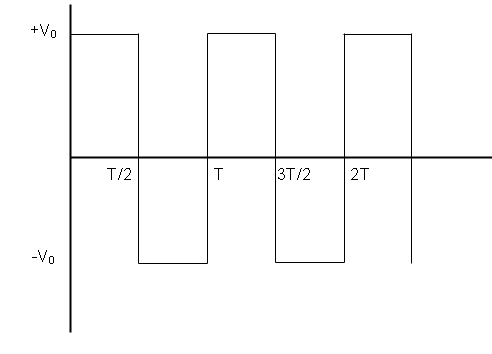
The average and RMS value of voltage for square waves shown in the fig. having a peak value ${V_0}$ are:

(A) $\dfrac{{{V_0}}}{{\sqrt 2 }},\sqrt 2 {V_0}$
(B) $\sqrt 2 {V_0},\dfrac{{{V_0}}}{{\sqrt 2 }}$
(C) ${V_0},{V_0}$
(D) Zero, ${V_0}$
Answer
139.5k+ views
Hint: In this solution, we will use the formula of average and RMS value. We only need to consider one cycle of the voltage to calculate the average and RMS value.
Complete step by step answer:
In the graph given to us, we want to calculate the average and RMS value of voltage.
The average amplitude is the mathematical “mean” of all a waveform’s points over the period of one cycle. It can be mathematically calculated as:
${V_{avg}} = \dfrac{1}{T}\int {{V_0}dt} $
We can see that the waveform of the voltage starts a cycle at $t = 0$ and ends the cycle at $t = T$. To calculate the integral of the wave function given to us, we need to break the integral down into regions where the voltage has constant values. So, we can write
${V_{avg}} = \dfrac{1}{T}\left( {\int\limits_{t = 0}^{t = T/2} {{V_0}dt + } \int\limits_{t = T/2}^{t = T} { - {V_0}dt} } \right)$
The ${V_0}$ term can be taken out of the integral since it is constant. The integral can then be simplified to
${V_{avg}} = \dfrac{{{V_0}}}{T}\left( {\dfrac{T}{2} + \dfrac{T}{2} - T} \right)$
$ \Rightarrow {V_{avg}} = 0$
Hence the average voltage will be zero.
Now, The RMS value stands for Root Mean Square value. It is a way of expressing an AC quantity of voltage or current in terms functionally equivalent to DC. It can be mathematically calculated as
${V_{RMS}} = \sqrt {\dfrac{1}{T}\int\limits_{t = 0}^T {{V^2}dt} } $
The integral can be broken into two parts as
${V_{RMS}} = \sqrt {\dfrac{1}{T}\left( {\int\limits_{t = 0}^{t = T/2} {V_0^2dt} + \int\limits_{t = T/2}^{t = T} {V_0^2dt} } \right)} $
The integral can be simplified as
${V_{RMS}} = \sqrt {\dfrac{{{V_0}^2}}{T}T} $
Or,
${V_{RMS}} = {V_0}$
Hence the correct choice is option (D).
Note: While calculating the average and the RMS value, we must not forget the $1/T$ term outside the integral. We can also find the average value graphically as zero since the area of the graph for one time period is the same in the positive and negative regime and as such, the average value will be zero.
Complete step by step answer:
In the graph given to us, we want to calculate the average and RMS value of voltage.
The average amplitude is the mathematical “mean” of all a waveform’s points over the period of one cycle. It can be mathematically calculated as:
${V_{avg}} = \dfrac{1}{T}\int {{V_0}dt} $
We can see that the waveform of the voltage starts a cycle at $t = 0$ and ends the cycle at $t = T$. To calculate the integral of the wave function given to us, we need to break the integral down into regions where the voltage has constant values. So, we can write
${V_{avg}} = \dfrac{1}{T}\left( {\int\limits_{t = 0}^{t = T/2} {{V_0}dt + } \int\limits_{t = T/2}^{t = T} { - {V_0}dt} } \right)$
The ${V_0}$ term can be taken out of the integral since it is constant. The integral can then be simplified to
${V_{avg}} = \dfrac{{{V_0}}}{T}\left( {\dfrac{T}{2} + \dfrac{T}{2} - T} \right)$
$ \Rightarrow {V_{avg}} = 0$
Hence the average voltage will be zero.
Now, The RMS value stands for Root Mean Square value. It is a way of expressing an AC quantity of voltage or current in terms functionally equivalent to DC. It can be mathematically calculated as
${V_{RMS}} = \sqrt {\dfrac{1}{T}\int\limits_{t = 0}^T {{V^2}dt} } $
The integral can be broken into two parts as
${V_{RMS}} = \sqrt {\dfrac{1}{T}\left( {\int\limits_{t = 0}^{t = T/2} {V_0^2dt} + \int\limits_{t = T/2}^{t = T} {V_0^2dt} } \right)} $
The integral can be simplified as
${V_{RMS}} = \sqrt {\dfrac{{{V_0}^2}}{T}T} $
Or,
${V_{RMS}} = {V_0}$
Hence the correct choice is option (D).
Note: While calculating the average and the RMS value, we must not forget the $1/T$ term outside the integral. We can also find the average value graphically as zero since the area of the graph for one time period is the same in the positive and negative regime and as such, the average value will be zero.
Recently Updated Pages
Average fee range for JEE coaching in India- Complete Details

Difference Between Rows and Columns: JEE Main 2024

Difference Between Length and Height: JEE Main 2024

Difference Between Natural and Whole Numbers: JEE Main 2024

Algebraic Formula

Difference Between Constants and Variables: JEE Main 2024

Trending doubts
JEE Main 2025 Session 2: Application Form (Out), Exam Dates (Released), Eligibility, & More

JEE Main 2025: Derivation of Equation of Trajectory in Physics

A point charge + 20mu C is at a distance 6cm directly class 12 physics JEE_Main

Learn About Angle Of Deviation In Prism: JEE Main Physics 2025

Electric Field Due to Uniformly Charged Ring for JEE Main 2025 - Formula and Derivation

JEE Main 2025: Conversion of Galvanometer Into Ammeter And Voltmeter in Physics

Other Pages
JEE Advanced Marks vs Ranks 2025: Understanding Category-wise Qualifying Marks and Previous Year Cut-offs

Degree of Dissociation and Its Formula With Solved Example for JEE

Electric field due to uniformly charged sphere class 12 physics JEE_Main

Dual Nature of Radiation and Matter Class 12 Notes: CBSE Physics Chapter 11

Formula for number of images formed by two plane mirrors class 12 physics JEE_Main

A conducting loop carrying a current is placed in a class 12 physics JEE_Main




